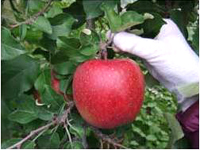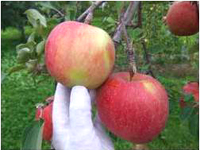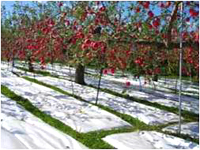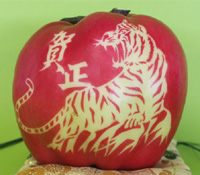Cultivation with care
cultivation with care | ▼Notable Contributors | ▼process of apple cultivationIn Aomori, one apple goes through 10 stages by growers before harvest. This assures consumers a better quality apple.
The average Japanese white-collar man’s working hours are 2085 per year, whereas apple growers worked 2700 hours, in 2005. This shows that they strive to produce good apples with time and passion, even in this highly developed era of machines and techniques.
One stage in the apple-growing process is bagging. In old times un-bagged cultivation was the mainstream. Around the middle of the19th century, fruit pests caused huge damage and made apple growing very difficult. To countermeasure disease and insects damage, bagging was applied.
It not only guarded against pests, but also smoothed and colored the skins of apples. The improved look of apples increased their value and the practice of bagging spread widely. Thus began the pursuit of high quality apple cultivation, despite an increase in farm labor.
Later, other countermeasures for pests were found and it was realized that bagging was not suitable for all varieties of apples. The researchers developed single, double and triple
layers of bags depending on the variety. The growers became more conscious of coloring
of apples. Bagging also gave apples ultra thin skin to enjoy crispness, and a longer storage period to enable fresh eating.
 |
 |
 |
 |
|||
Bagged |
Un-wrapped once Showing the second bag |
un-bagged |
Colored |
In order to color the shaded area of an apple, leaf-removing and apple-turning are conducted. Moreover, the sunlight reflecting sheet was introduced to color the bottom of apples. Now the whole apple can successfully become red.
Un-bagged cultivation makes the skin a little thicker and the red color dull. However the fruits receive a lot of sunshine through the removal of leaves and rotation; as a result the fruits get darker and sweeter. They tend to have a honey core in the flesh depending on the variety and this makes them popular among consumers.
We market bagged and un-bagged apples, depending on the time of year and consumer demands.
 |
 |
 |
Removing leaves |
Rotating apples |
Reflecting sheet |
| Picture and writing on Apples An effective use of bagged cultivation is the drawing and writing on apples. The naturalyellow skin color and tanned red make fine-skilled art. |
 |







